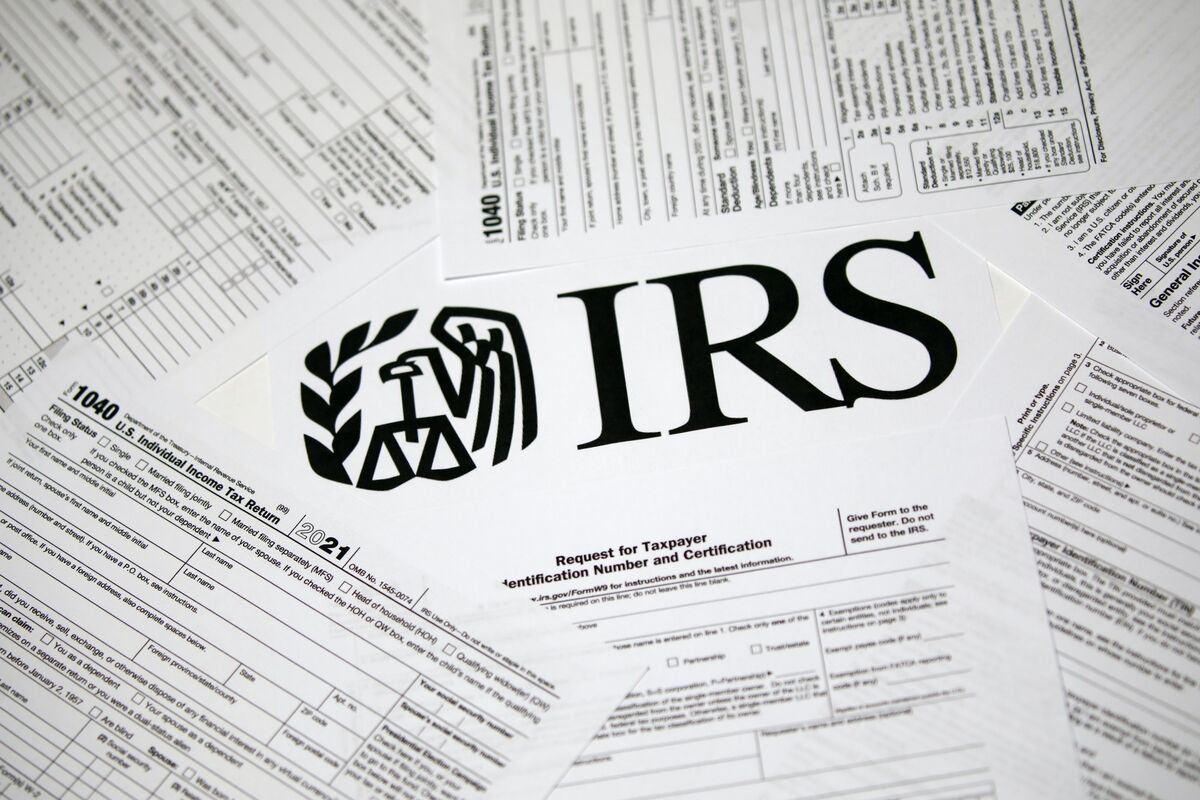Home>Finance>How Do You Sign A Tax Return For A Deceased Person


Finance
How Do You Sign A Tax Return For A Deceased Person
Modified: February 21, 2024
Learn how to sign a tax return for a deceased person in this comprehensive finance guide. Ensure proper documentation and avoid any legal complications.
(Many of the links in this article redirect to a specific reviewed product. Your purchase of these products through affiliate links helps to generate commission for LiveWell, at no extra cost. Learn more)
Table of Contents
- Introduction
- Understanding the Role of the Taxpayer
- Determining Who Can Sign the Tax Return
- Signing as a Personal Representative
- Signing as a Surviving Spouse
- Signing as a Legal Guardian or Parent
- Signing as an Executor or Administrator of the Estate
- Obtaining and Submitting the Required Documentation
- Tax Implications for the Deceased Person’s Estate
- Conclusion
Introduction
Signing a tax return is a crucial step in the annual tax filing process. It ensures that the information provided is accurate and that the taxpayer takes responsibility for their financial obligations. But what happens when the taxpayer is no longer alive? How do you sign a tax return for a deceased person?
Dealing with the tax affairs of a deceased individual can be a complex and overwhelming task. It requires a clear understanding of the legal and administrative procedures involved. This article aims to provide a comprehensive guide on how to sign a tax return for a deceased person, outlining the different scenarios and responsibilities for those who represent the deceased for tax purposes.
While the process may vary depending on the specific circumstances, there are general guidelines that can help navigate the situation. These guidelines are essential to ensure compliance with tax laws and avoid any potential penalties or legal complications.
It is important to mention that seeking professional advice from tax specialists or lawyers specializing in estate planning and administration is highly recommended. They can provide personalized guidance and ensure that all legal requirements are met.
Now, let’s delve into the various scenarios and legal considerations involved in signing a tax return for a deceased person.
Understanding the Role of the Taxpayer
Before exploring how to sign a tax return for a deceased person, it is crucial to understand the role of the taxpayer, even after death. The taxpayer, in this case, refers to the deceased individual who would have been responsible for filing their own tax returns while alive.
In general, a taxpayer is required to file a tax return for the year of their death, just like any other taxpayer. The tax return includes reporting the income earned from the start of the tax year up until the date of death. It is important to note that any income earned after the date of death is typically reported on a separate tax return for the deceased person’s estate.
It is the responsibility of the taxpayer, while alive, to report all sources of income, including any employment income, investment income, rental income, or business profits. The taxpayer is also responsible for claiming available deductions, credits, and exemptions to minimize their tax liability.
Now that we have a basic understanding of the role of the taxpayer, let’s explore the different scenarios and individuals who may be authorized to sign the tax return on behalf of the deceased person.
Determining Who Can Sign the Tax Return
When it comes to signing a tax return for a deceased person, it is important to establish who has the legal authority to act on behalf of the deceased for tax purposes. The specific circumstances and the presence of a will or estate plan will determine who can fulfill this role.
Here are some of the common scenarios in which someone may be authorized to sign the tax return:
- Personal Representative: If the deceased person appointed a personal representative or executor in their will or estate plan, this individual has the authority to handle their financial affairs, including signing the tax return on their behalf. The personal representative is typically responsible for gathering the necessary financial information, filing the tax return accurately, and fulfilling any tax obligations of the deceased.
- Surviving Spouse: If the deceased person was married and the surviving spouse is filing a joint tax return, the surviving spouse can sign the tax return. This applies even if the surviving spouse is not the personal representative or executor of the estate. However, it is important to note that this authority only extends to the year of the spouse’s death.
- Legal Guardian or Parent: In the case of a minor child who has lost their parent, a legal guardian or parent can sign the tax return on behalf of the deceased. This responsibility falls upon the person legally appointed as the guardian or the surviving parent, if applicable.
It is crucial to consult with legal and tax professionals to determine the specific requirements and authorizations based on your situation. They can provide guidance on who is eligible to sign the tax return and guide you through the necessary steps to ensure compliance with tax laws.
In the next sections, we will explore the process of signing the tax return for a deceased person in each of the respective scenarios, including the required documentation and considerations to keep in mind.
Signing as a Personal Representative
When a deceased person appoints a personal representative or executor in their will or estate plan, this individual is responsible for handling the deceased person’s financial affairs, including signing the tax return on their behalf.
As a personal representative, it is crucial to gather all the necessary financial information and documents to accurately file the tax return. This includes gathering income statements, expense records, and any relevant tax documents such as W-2s, 1099s, and receipts.
Here are the steps to follow when signing the tax return as a personal representative:
- Obtain Letters Testamentary or Letters of Administration: These are legal documents issued by the court that grant the personal representative the authority to act on behalf of the deceased person’s estate. These letters serve as proof that you have the legal authority to sign the tax return.
- Complete the Tax Return: Using the financial information gathered, complete the tax return accurately. Ensure that all income, deductions, and credits are reported correctly.
- Sign the Tax Return: As the personal representative, you will typically sign the tax return using the following format: “Your Name, Personal Representative for the Estate of [Deceased Person’s Name].” This makes it clear that you are signing in your capacity as the personal representative.
- Include the Required Documentation: Attach a copy of the Letters Testamentary or Letters of Administration to the tax return. This serves as proof of your authority to sign the return on behalf of the deceased person.
- File the Tax Return: Once the tax return is signed and all required documentation is attached, file the tax return with the appropriate tax authorities. This may involve mailing a paper return or electronically submitting the return, depending on the filing requirements.
It is essential to keep a copy of the signed tax return, along with all supporting documentation, for your records. Additionally, consult with tax professionals or legal advisors to ensure compliance with any specific state or local laws regarding tax filing for a deceased person.
Now that we have covered signing as a personal representative, let’s explore the next scenario: signing as a surviving spouse.
Signing as a Surviving Spouse
When a deceased person was married, the surviving spouse has the authority to sign the tax return, especially if they are filing a joint return for the year of their spouse’s death.
Here are the steps to follow when signing the tax return as a surviving spouse:
- Gather the Necessary Information: Collect all the relevant financial information, including income statements, deductions, and credits, for both yourself and your deceased spouse.
- Complete the Tax Return: Use the gathered information to accurately complete the tax return, ensuring that all income, deductions, and credits are reported correctly.
- Sign the Tax Return: As the surviving spouse, you will sign the tax return using the following format: “Your Name, surviving spouse.” This clearly indicates that you are signing the return as the surviving spouse of the deceased person.
- Include Additional Documentation: Attach a copy of the deceased person’s death certificate to the tax return. This serves as proof of their passing and supports your claim as the surviving spouse signing the return.
- File the Tax Return: Once the tax return is signed and all required documentation is attached, file the return with the appropriate tax authorities. Make sure to follow the filing instructions provided by the tax authorities, whether it is mailing a paper return or submitting the return electronically.
It is important to note that the authority to sign the tax return as a surviving spouse typically extends to the year of the spouse’s death. For future tax years, the surviving spouse may need to consult with a tax professional or legal advisor to determine the appropriate filing status and sign the return accordingly.
Consulting with tax professionals is highly recommended, particularly if the situation involves complex tax matters or if there are specific state or local laws that need to be considered.
Now that we have covered signing as a surviving spouse, let’s explore the next scenario: signing as a legal guardian or parent.
Signing as a Legal Guardian or Parent
In the case of a deceased individual who was a parent or had minor children, a legal guardian or parent may be authorized to sign the tax return on behalf of the deceased.
If you are a legal guardian or parent tasked with signing the tax return, here are the steps to follow:
- Gather the Relevant Information: Collect all necessary financial information, including income statements, deductions, and credits, for the deceased person.
- Complete the Tax Return: Use the gathered information to accurately complete the tax return, ensuring that all income, deductions, and credits are reported correctly.
- Sign the Tax Return: As the legal guardian or parent, you will sign the tax return using your name and indicating your relationship to the deceased person. For example, you may sign as “Your Name, Legal Guardian of [Deceased Person’s Name]” or “Your Name, Parent of [Deceased Person’s Name].”
- Provide Supporting Documentation: If you are signing the tax return as a legal guardian, attach a copy of the court order or legal document designating you as the legal guardian. Alternatively, if you are signing as a parent, you may need to provide proof of your relationship to the deceased person, such as a birth certificate.
- File the Tax Return: Once the tax return is signed and all necessary documentation is attached, file the return according to the instructions provided by the tax authorities. This may involve mailing a paper return or electronically submitting the return.
It is important to consult with legal advisors or tax professionals to ensure that you have the proper authority to sign the tax return as a legal guardian or parent. They can provide guidance specific to your situation and advise on any additional requirements or considerations.
Now that we have covered signing as a legal guardian or parent, let’s proceed to the next scenario: signing as an executor or administrator of the estate.
Signing as an Executor or Administrator of the Estate
If the deceased person did not designate a personal representative or executor in their will or estate plan, the responsibility of signing the tax return falls to the executor or administrator of the estate. The executor or administrator is appointed by the court to handle the affairs of the deceased person’s estate.
When signing the tax return as an executor or administrator, follow these steps:
- Gather the Required Financial Information: Collect all relevant financial documents, including income statements, deductions, and credits, for the deceased person.
- Complete the Tax Return: Use the gathered information to accurately complete the tax return, ensuring that all income, deductions, and credits are reported correctly.
- Sign the Tax Return: As the executor or administrator of the estate, you will sign the tax return using the following format: “Your Name, Executor/Administrator for the Estate of [Deceased Person’s Name].” This indicates that you are signing the return in your capacity as the executor or administrator of the estate.
- Include Relevant Documentation: Attach a copy of the court order or legal document appointing you as the executor or administrator of the estate. This serves as proof of your authority to act on behalf of the deceased person’s estate.
- File the Tax Return: Once the tax return is signed and all necessary documentation is attached, file the return with the appropriate tax authorities. Follow the instructions provided by the tax authorities to ensure proper filing, whether it involves mailing a paper return or electronically submitting the return.
Keep copies of the signed tax return, along with all supporting documentation, for your records. Consulting with tax professionals or legal advisors is recommended to ensure compliance with any specific state or local requirements.
It is important to note that the responsibilities of the executor or administrator extend beyond signing the tax return. They are responsible for handling all financial and legal matters pertaining to the deceased person’s estate.
Now that we have covered signing as an executor or administrator of the estate, let’s move on to the next section discussing the required documentation and considerations for signing the tax return for a deceased person.
Obtaining and Submitting the Required Documentation
When signing a tax return for a deceased person, it is crucial to gather and submit the necessary documentation to support your authority and ensure compliance with tax laws. The specific documentation required may vary depending on the circumstances and the role you are fulfilling.
Here are some common documents that may be required:
- Letters Testamentary or Letters of Administration: If you are a personal representative or executor of the estate, you will need to obtain these legal documents from the court. They serve as proof of your authority to act on behalf of the deceased person’s estate.
- Death Certificate: A certified copy of the deceased person’s death certificate is often required to confirm their passing and support your claim as a surviving spouse, legal guardian, or executor of the estate.
- Court Orders or Legal Documents: Depending on the circumstances, you may need to provide court orders or legal documents that grant you the authority to sign the tax return on behalf of the deceased person. This could include documents appointing you as a legal guardian or specifying your role as an executor or administrator of the estate.
- Tax Identification Number: In most cases, you will need to obtain an Employer Identification Number (EIN) for the deceased person’s estate if one has not already been assigned. This number will be used to identify the estate when filing the tax return.
- Financial Statements and Records: Gather all relevant financial information, such as income statements, expense records, and receipts, to accurately report the deceased person’s financial activity on the tax return.
It is important to keep copies of all the documentation and retain them for your records. If you are unsure about which documents are required or how to obtain them, consult with tax professionals or legal advisors who can guide you through the process.
When submitting the tax return, make sure to include copies of the required documentation as instructed by the tax authorities. This ensures that the return is complete and supported by the necessary evidence of your authority to sign on behalf of the deceased person.
By obtaining and submitting the required documentation, you demonstrate your compliance with tax laws and maintain the necessary records for any potential audits or inquiries.
In the next section, we will discuss the tax implications that arise from filing a tax return for a deceased person’s estate.
Tax Implications for the Deceased Person’s Estate
Filing a tax return for a deceased person’s estate comes with specific tax implications that need to be considered. These implications arise from the income earned by the estate, any distributions made to beneficiaries, and the potential need to establish a separate tax entity for the estate.
Here are some key tax considerations for a deceased person’s estate:
- Income Tax Return: As the personal representative, executor, or administrator of the estate, you may need to file an income tax return for the estate. This return reports the income earned by the estate from the date of death until the close of the estate. The income tax return for the estate is typically filed using the estate’s tax identification number (EIN) obtained from the IRS.
- Estate Income and Expenses: The estate’s income could come from various sources, such as investment income, rental income, or business income generated by the estate’s assets. Deductions and expenses incurred by the estate, including administrative expenses and legal fees, can offset the taxable income.
- Beneficiary Distributions: If the estate makes distributions to beneficiaries, it may be necessary to report these distributions on the estate’s tax return. The beneficiaries receiving the distributions may have their own tax obligations, depending on the nature of the distribution and their own tax situation.
- Potential Estate Tax: Depending on the value of the deceased person’s estate, there may be potential estate tax obligations. Estate tax laws vary by jurisdiction, and it is essential to consult with tax professionals or legal advisors to assess any potential estate tax liabilities.
- State and Local Taxes: In addition to federal taxes, the estate may also be subject to state and local taxes. It is important to consider and comply with the specific requirements and regulations of the jurisdiction in which the estate is being administered.
As tax laws can be complex and vary depending on the circumstances, it is highly advisable to consult with tax professionals or legal advisors who specialize in estate planning and administration. They can provide tailored guidance and ensure compliance with all applicable tax laws.
By understanding and addressing the tax implications associated with the deceased person’s estate, you can effectively manage the estate’s tax obligations and minimize any potential tax liabilities.
Now, let’s conclude our discussion on signing a tax return for a deceased person.
Conclusion
Signing a tax return for a deceased person is a complex and important responsibility that requires careful consideration and adherence to legal and tax requirements. Understanding the role of the taxpayer, determining who can sign the tax return, and obtaining the necessary documentation are key aspects to consider.
Whether you are a personal representative, surviving spouse, legal guardian, or executor of the estate, it is crucial to follow the appropriate steps outlined in this article. By doing so, you can ensure compliance with tax laws and uphold the financial obligations of the deceased person’s estate.
Additionally, consulting with tax professionals or legal advisors specializing in estate administration and tax matters is highly recommended. They can provide personalized guidance, address any specific questions or concerns, and ensure that all legal and tax requirements are met.
Remember that tax implications for a deceased person’s estate go beyond signing the tax return. Estate income, beneficiary distributions, potential estate taxes, and state and local tax obligations must all be considered and properly handled.
By navigating the tax filing process for a deceased person with care and attention to detail, you can fulfill your obligations and help bring financial closure to the estate.
Remember, this article serves as general information and should not be considered legal or tax advice. It is essential to consult with professionals who can provide customized guidance based on your specific circumstances.
Disclaimer: The content of this article is provided for informational purposes only and should not be construed as legal, financial, or tax advice. Consult with a professional tax advisor or attorney for legal and tax advice pertaining to your specific situation.














